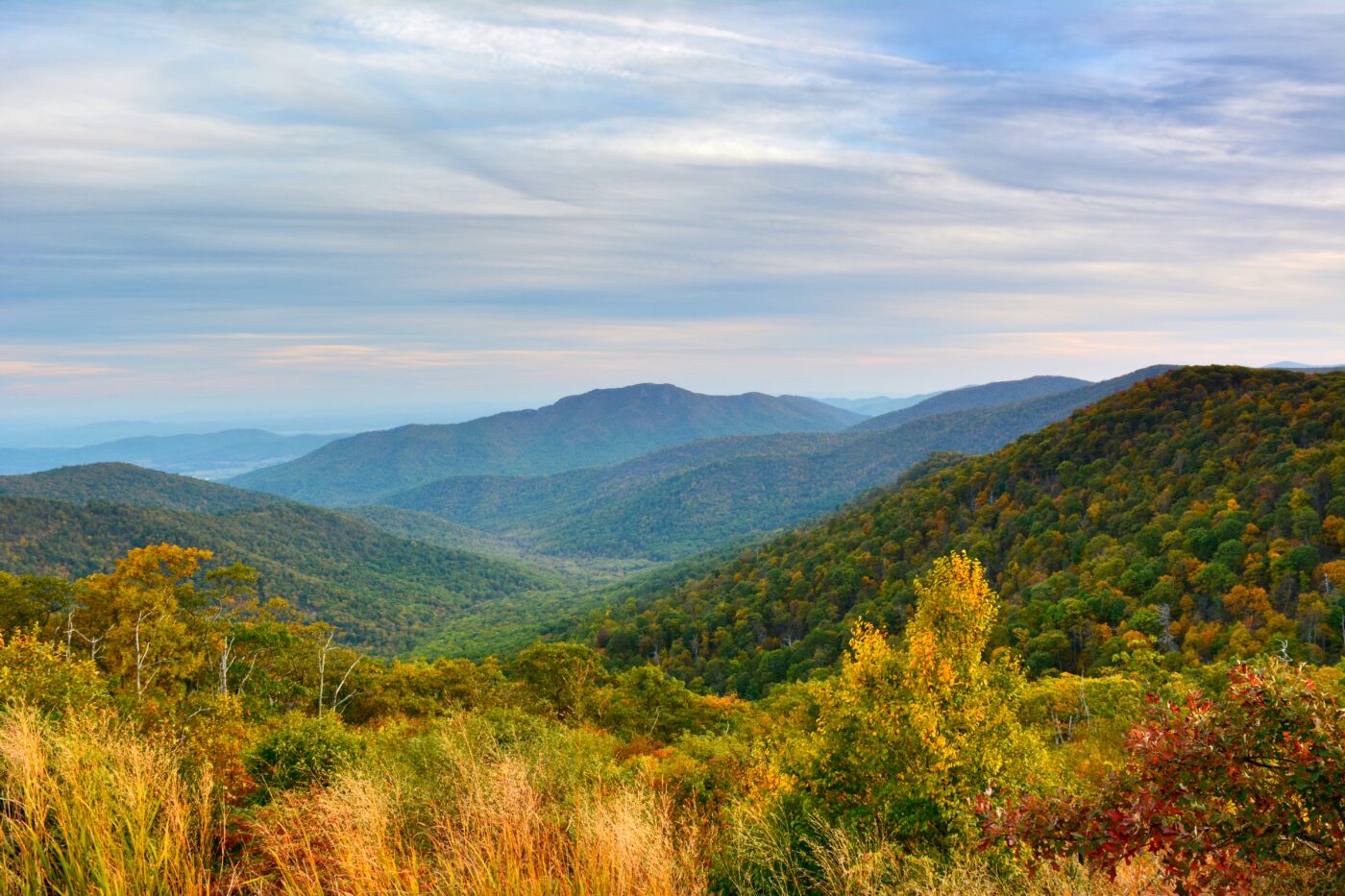
Shenandoah National Park has stunning views and near endless opportunities for outdoor recreation.
Shenandoah National Park has it all: craggy granite peaks rising from pastoral valleys, hushed wooded hollows that open up onto spectacular cascades, and fields bristling with wildflowers. It’s also closer than you might think. Just 75 miles from Washington, D.C., and 100 miles from Baltimore, the Virginia park is a popular destination to beat the heat in the summer and take in fall’s full Technicolor glory. But really, it’s must-visit any time of the year.
Whether you’re visiting for the first time or heading back for more, we’ve compiled the best tips to make the most of your adventure. With recommendations from AMC trip leader Peter Mason, experienced climber and AMC member Jason Reed, and AMC’s Best Day Hikes in the Shenandoah Valley by Jennifer Adach and Michael R. Martin, we’ll help set you up for the best possible visit.
Meet Shenandoah
Nestled in Virginia’s Blue Ridge Mountains, Shenandoah’s landscape is a breathtaking patchwork of bucolic hills and valleys, and dramatic mountain ridges. The main drag is Skyline Drive. The 105-mile road bisects the park from north to south, tracing the ridgeline that runs down the spine of the park.
Unless you’re doing some serious backpacking, it’s just about impossible to get around the park without spending some time on Skyline. Not that you’ll mind. The views from the road’s 75 scenic viewpoints are breathtaking, and it’ll deliver you to all the park’s highlights. It even has a convenient system of mileposts that are incredibly helpful when looking for specific trailheads or points of interest.
There are hikes in the park for all skill levels, ranging from pleasant meadow walks to strenuous summit ascent with rock scrambles. There’s even a slice of the storied Appalachian Trail (A.T.) that runs the length of the park. Depending on the time of year, you might run into thru-hikers hiking the entire 2,192 miles of the trail between Maine and Georgia.
You can also rock climb and bike, but we’d be remiss not to mention the park’s world-class trout fishing. When peak season winds down and snowflakes start to fly, the fun continues as snowshoers and cross-country skiers take over the park’s trails. It’s truly a choose-your-own-adventure destination.
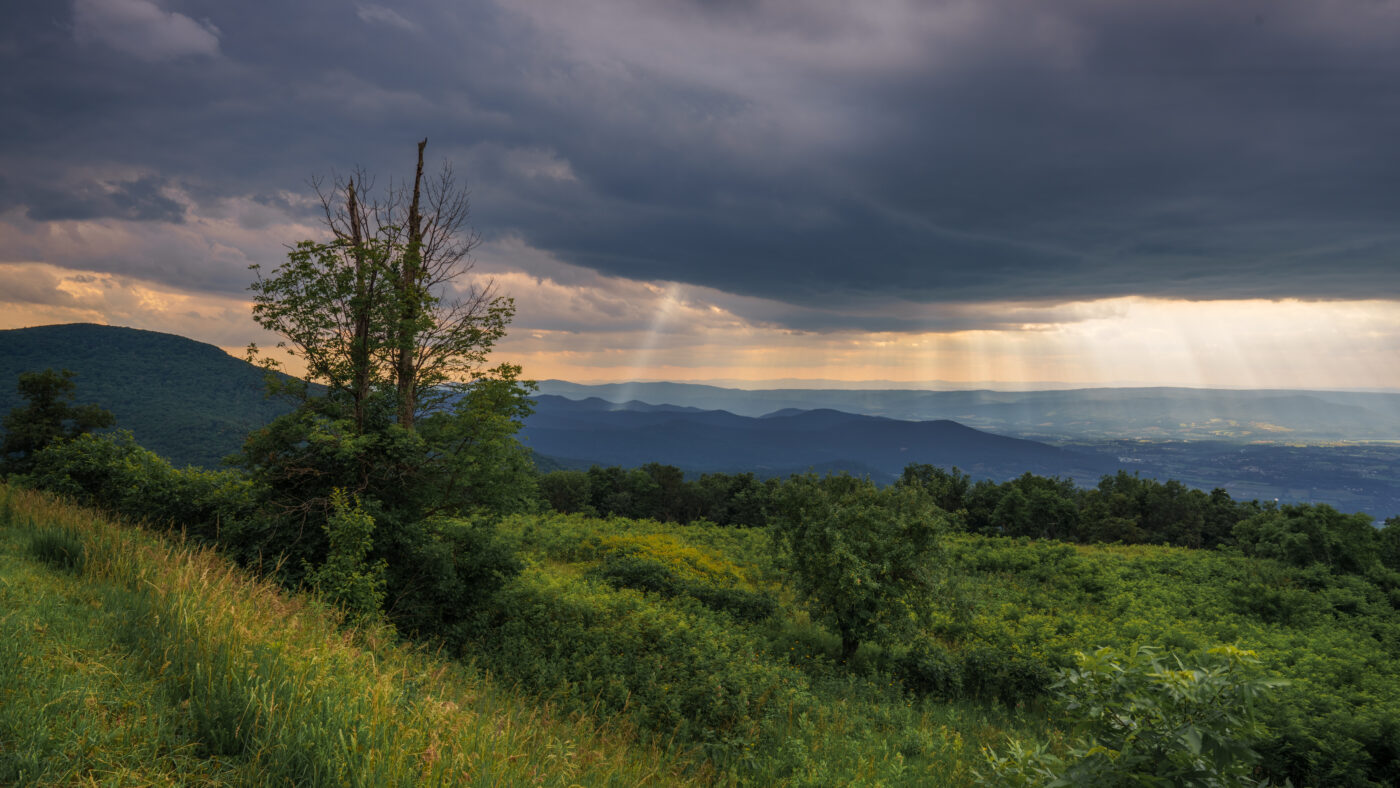
No matter what season you visit Shenandoah, make sure to check the weather forecast and don’t be afraid to turn back on your adventure if the weather turns bad.
When to Visit
Any time of year is a good time to be in Shenandoah. The scenery and recreation opportunities vary widely from season to season, and we have the inside scoop on how to make the most of each of them.
Summer
There’s no way around it, it’s going to be busy but don’t let that scare you off! You probably won’t care once you’re relaxing in a swimming hole or standing at a scenic viewpoint taking in a knockout view. Plus, we’ve got some tips to help you avoid the crowds.
Timing your trip: Weekdays are less busy than weekends, so consider planning a mid-week visit or plan to hit the most popular spots then. If you’re looking to section-hike this portion of the A.T., plan to visit in July or August when most thru-hikers have already passed through to reduce congestion on the trail.
Get there early and plan ahead: Arrive early to avoid long lines at entrance stations, limited parking, and crowded trails. You can also buy entrance passes in advance and special lanes are available at entrance stations for visitors with pre-purchased passes. You should also make your lodging or camping reservations ahead of time. When the park is at its busiest, first-come, first-served campsites can fill up for the weekend by Thursday.
Choose a less-crowded entrance: The park recommends that visitors enter through the less-busy Swift Run or Rockfishentrance stations. If you’re driving southbound this makes for a longer trip, but you’ll have some seriously gorgeous scenery to keep you company.
Fall
Shenandoah is famous for its stunning fall foliage, but if you’re planning on leaf peeping you won’t be alone! Fall is the park’s busiest time of year (even more so than summer), so the same tips apply to avoid the crowds. However, there are couple other things you can do to make the most of your visit.
Keep an eye on the foliage: Planning a trip around when the fall foliage peaks can be a little tricky since the park is so large and the elevation varies so widely. Keep an eye on the park’s social media for the most up-to-date predications or their mountain view webcam to see what the color looks like in real time.
Find the hidden gems: You’re sure to find plenty of full parking lots and over-crowded viewpoints, but don’t get discouraged. Use this as an opportunity go off the beaten path. The National Park Service maintains a list of less-busy hikes that just might help you find some solitude. As a bonus, you’ll be taking some pressure off busy trails that can become damaged from overuse.
Winter
Many of the park’s services shut down in the winter months, but you can still make the most out of this quiet season. Once the leaves drop, heavily forested trails reveal stunning new vistas and wildlife spotting becomes even easier. Snowfall creates new opportunities for recreation and solitude is easier to come by—just make sure you’re well prepared. Skyline Drive is often closed to vehicles when there’s ice and snow, so keep an eye on the park’s social media for closure notices and plan to hike, snowshoe or ski in from an entrance station or boundary entry point if necessary.
Be prepared for the chill: Temperatures hover in the low 20 to high 30 degrees Fahrenheit. Also, since the park sits at a higher elevation than the nearby valley, it generally receives more ice and snow. Pack extra warm clothes and blankets in case you have car trouble or conditions change when you’re on an adventure. For a full list of winter essentials, check out our winter gear list.
Keep safety top of mind: Before you enter the park, make sure you have a full tank of gas. There’s fuel available at Big Meadows but the pumps can be unreliable in the cold months. You should also review the park’s list of phones and other facilities that are available during winter and watch out for road closures. If Skyline Drive is closed due to snowy or icy conditions, and it can take days or weeks to clear.
Spring
This season has something for everyone. Hikers seeking solitude (without winter’s bitter cold) can find it more easily than during summer and fall. Birdwatchers will delight at the masses of migratory birds that stopover in the park on their journeys north. There’s so much to see and enjoy, you won’t want to miss any of it.
Look down and look up: Spring offers fall some serious competition for the most beautiful season in Shenandoah. The park hosts 862 recorded species of wildflowers with different ones popping all season long. They even maintain a calendar that tracks when each species is in bloom and host an annual wildflower celebration.
Above the drama of bursting buds, the relatively light leaf cover makes it one of the best times to birdwatch. The park’s dense forest and high ridgeline attract neotropical migratory species like the Cerulean Warbler.
Stay weather aware: Make sure you’re prepared for whatever the season throws at you. It’s not uncommon to see significant snowfall as late as March and there’s a chance of snow (along with chilly temps) through April. Lucky visitors may arrive during a warm front that brings temperatures above 70 degrees, but conditions can vary widely from day to day. Dress in layers, pack a rain jacket and check the weather forecast.
In fact, whichever season you decide to visit, be sure to pack plenty of layers. The park’s higher elevations are comprised of a spectacular stretch of wooded highlands that stays about ten degrees Fahrenheit cooler than lower elevations. This can be a real treat, but you might find yourself feeling an unexpected chill.
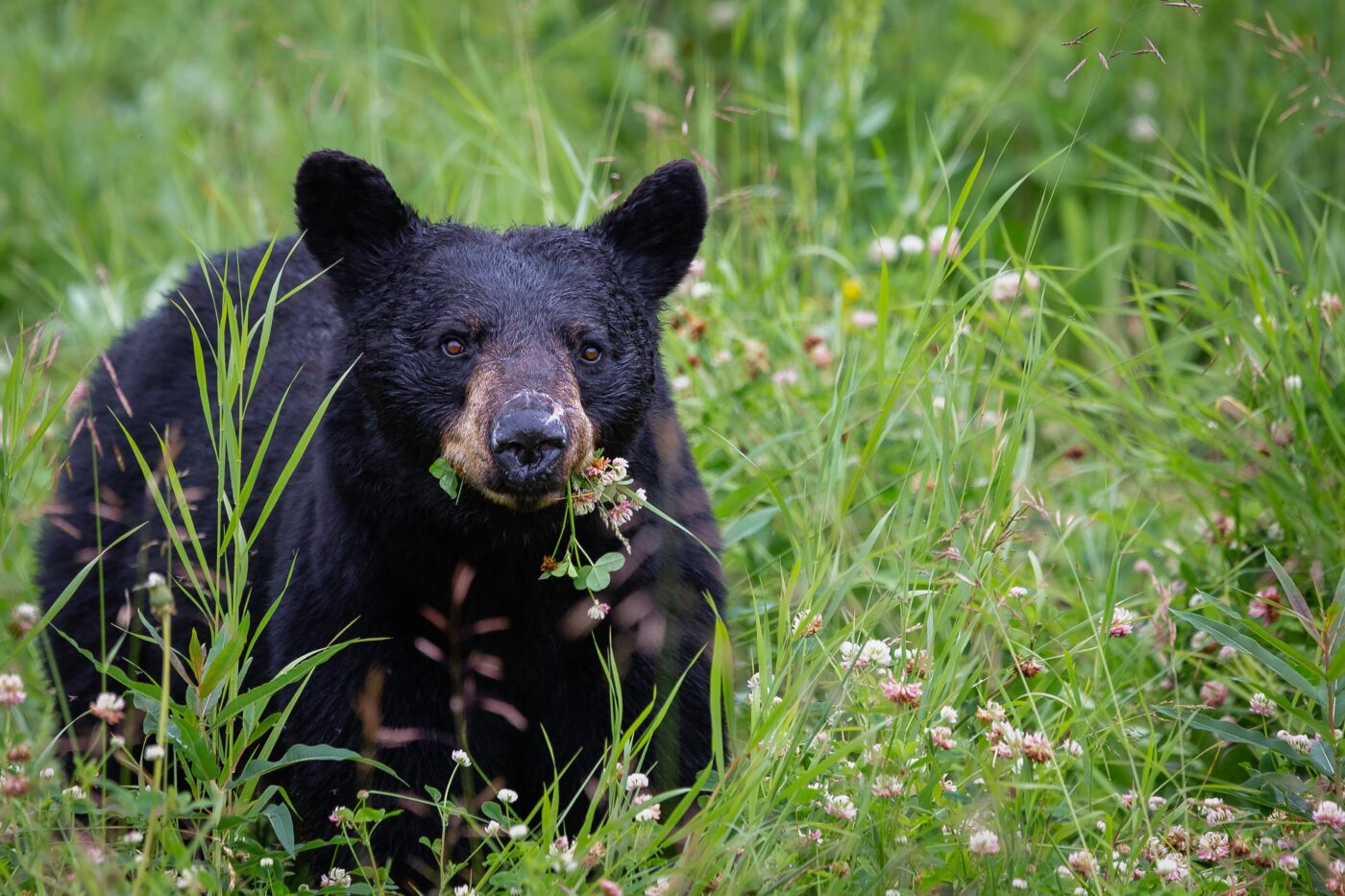
If you spend enough time in the park, you’ll probably see a black bear but following a few basic safety tips can keep you safe.
How to Stay Safe
When you’re planning any trip that involves an outdoor adventure you should always pack the 10 Essentials and brush up on Leave No Trace (LNT) principles. One of the most important LNT principles to observe in Shenandoah is “respect wildlife.” These include the park’s black bears and two species of venomous snakes.
The park has great resources on bear and snake safety so you’ll know exactly what to do if you encounter one. Ticks are also common so learn how to deter and remove them. Poison ivy is also widespread throughout the park, so familiarize yourself with what it looks like so you can avoid it.
Getting There
Most visitors from outside the region fly into Washington, D.C., and make the two-hour drive to Shenandoah. There are smaller regional airports closer to the park, including Shenandoah Valley Regional in Weyers Cave and Charlottesville-Albemarle in Charlottesville, but they are more expensive to fly into.
There are four entrances to the park along Skyline Drive: Front Royal (Northern Entrance), Thornton Gap, Swift Run, and Rockfish Gap (Southern Entrance). Take advantage of not needing to come and go through the same entrance to experience more of what the park has to offer, especially during peak season when Front Royal and Thorton Gap become extremely busy.
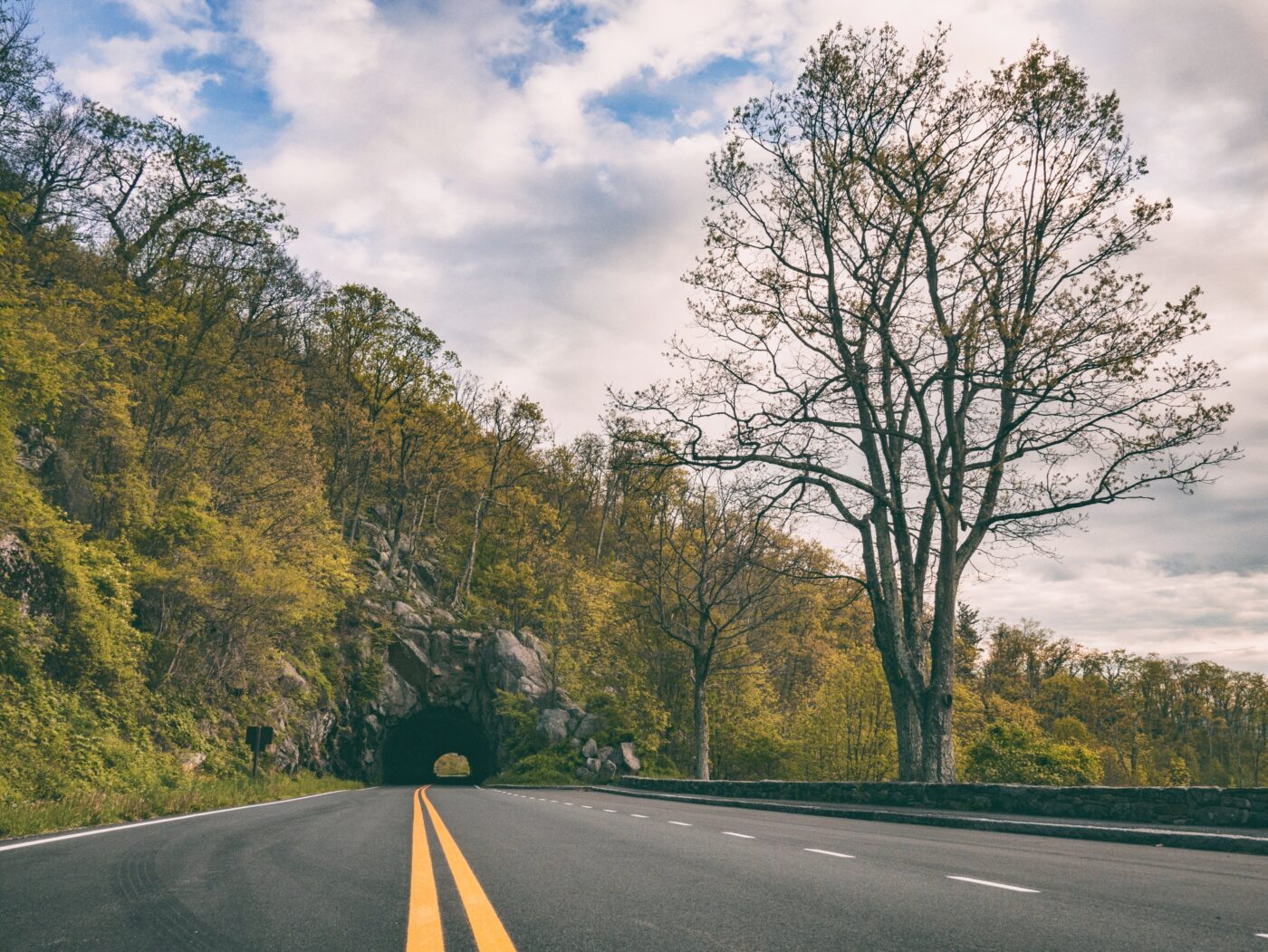
Scenic Skyline Drive will take you to all the park’s highlights.
Getting Around
Skyline Drive—the only road in Shenandoah National Park—is one of the most scenic drives in the country, delivering visitors to almost all the park’s highlights. Most folks treat the park like a “drive-through” experience and only leave their cars for short nature walks or to take in a scenic vista.
Just be sure to drive carefully. The speed limit is 35 miles per hour. Vehicles share the road with cyclists, hikers, and wildlife, and there plenty of steep hills and blind curves where visibility can be limited.
Where to Stay
Looking for a comfortable lodge stay? Or is camping in the backcountry, miles away from anyone else, more your thing? You can do it at Shenandoah, along with staying in a rustic cabin or at campground loaded with amenities.
Lodges: There are two lodges in the heart of the park: Skyland (Milepost 47) and Big Meadows (Milepost 51). They’re both at high elevations so they have stunning views of the Shenandoah Valley. Accommodations at both range from premium rooms in the main lodge to detached cabins, but Skyland takes the prize for the most upscale accommodations due to a recent renovation. The lodges close for the winter in November and reopen in May.
Cabins: If you’re looking for a more rustic experience but aren’t quite up for camping, check out Lewis Mountain Cabins (Milepost 57.5). They have plenty of amenities like private bathrooms and heating, and as bonus you’ll feel a little closer to nature than staying at a lodge.
The Potomac Appalachian Trail Club also operates six cabins within the park. You’ll need to hike into them and they’re more primitive than the park’s other lodging offerings. They also have a lot of history, with some built by the Civilian Conservation Corps nearly a century ago and others by former residents of the land. They offer a truly unique backcountry experience for intrepid adventurers.
Front-country camping: If camping is more your style, then you’re in luck. There are five front-country campgrounds located along Skyline Drive where you can sleep under the stars. AMC trip leader Peter Mason’s favorite spot to camp is Lewis Mountain Campground (Milepost 57.5). It’s the smallest campground in the park with just 30 tent sites, but it still has plenty of amenities and tends to be on the quieter side. It’s also just 7 miles away from Big Meadows, so it’s plenty close to the park’s main attractions.
Backcountry camping: With more than 196,000 acres of backcountry and wilderness, Shenandoah is the perfect place to immerse yourself in the park’s natural beauty. There are designated backcountry campgrounds but the park also allowed “dispersed camping”—camping outside of these designated spots. This means you won’t have access to the amenities you might be used to at a front-country campground, but you’ll have the rare opportunity to find solitude in this busy park.
If you go this route, you’ll need a permit. The good news is that they’re free! They can be purchased online ahead of time or they can be acquired at the self-registration kiosks at the park’s four entrance stations, as well as the Old Rag and Whiteoak Canyon trailheads. Make sure you’re well-prepared and understand the regulations.
All campers should keep in mind that the park is home to black bears. Make sure to store your food in your vehicle, in a bear box, or either hang your food or store it in a bear canister.
Cost of Admission
A park entrance pass is required for all visitors. The current fee is $30 per vehicle, and the pass is valid for seven days. Discounted passes are available for motorcyclists and people who enter the park without a vehicle, including cyclists and hikers.
Annual passes for the park are available for $55. You can also purchase an annual America the Beautiful pass for $80 that provides you access to every national park and more than 2,000 federal recreation sites.
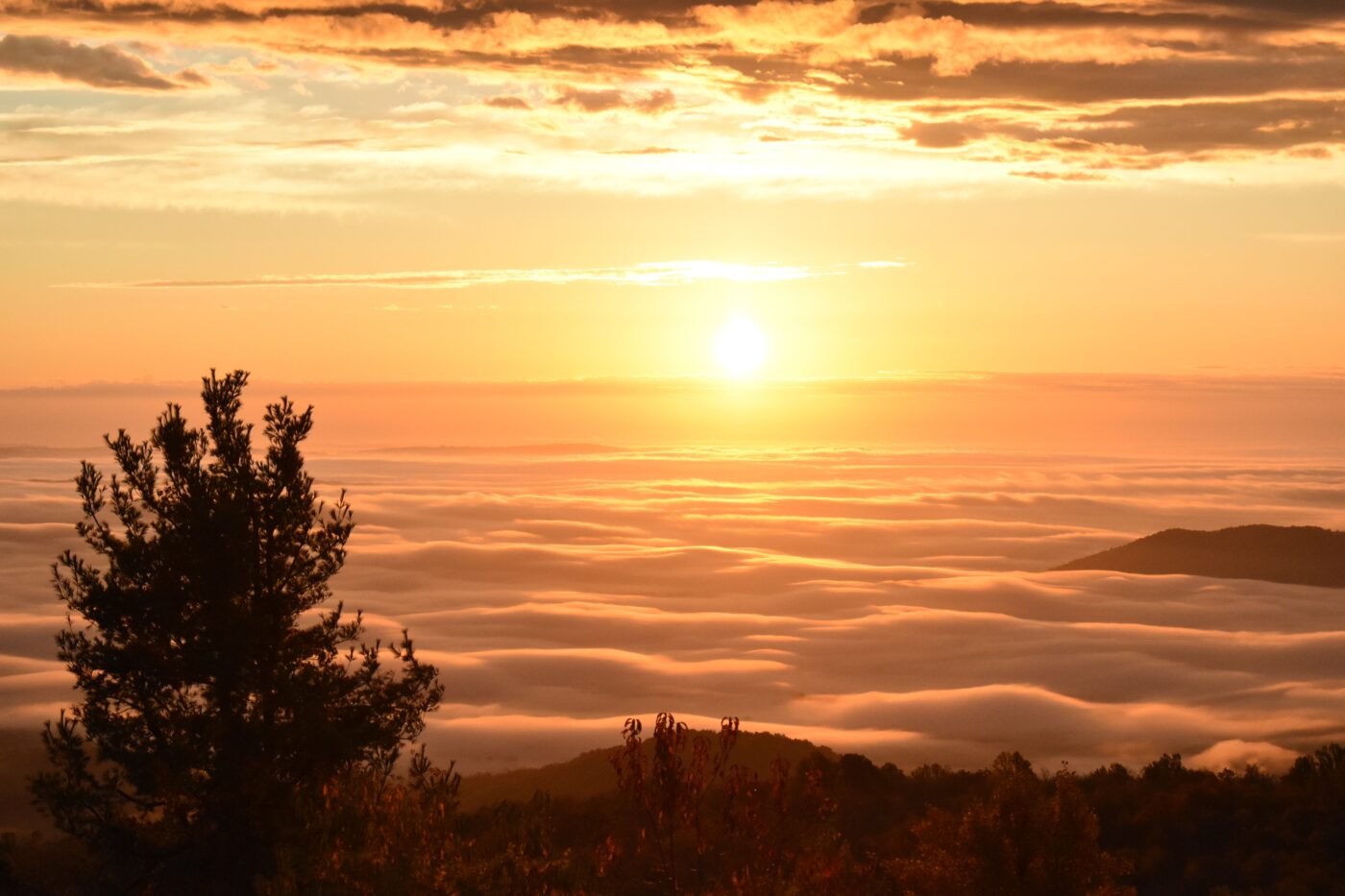
Whether it’s catching a sunrise (or sunset), climbing a mountain or enjoying a scenic drive, there’s plenty to do in Shenandoah.
What to Do
With 105 miles of Skyline Drive to explore, 500 miles of trails, nine waterfalls, and dozens of rocky outcrops and peaks, Shenandoah leaves you with no shortage of options for adventure. Even the visitor centers are worth an extended visit to learn about the park’s rich and complex history.
With so much do and see, it can feel overwhelming. If you’re new to the park it’s helpful to think of it as divided into three districts: the North District, Central District and Southern District. We’ve broken down the park’s highlights based on which district they’re in. Wherever you find yourself, you’ll know the best places to go.
For folks living in the Mid-Atlantic, AMC’s Potomac Chapter offers guided trips to the park.
North District
Shenandoah’s northern stretch of parkland hosts the busiest visitor entrances, but surprisingly, its trails aren’t as busy as you’d think. Most folks breeze through the area on their way to more popular attractions in the Central District, but they’re missing out.
A visit to Dicky Ridge Visitor Center near the Front Royal Entrance is one of the best ways to start out your trip to the park. Along with the usual maps and essentials, it hosts exhibits on the park’s human and natural history designed to deepen the understanding and appreciation you’ll have for the land you’re exploring.
Close to the visitor center, Fox Hollow Loop and Snead Farm Road are two short walks that delve into this history. Fox Hollow Loop passes old rock walls that once served as property boundaries, a cemetery, and periwinkles that were planted by former residents. If you’re doing this one with kids, the visitor center has a guide to the trail’s history to take on your walk and there’s even a guided tour on the park’s app. Snead Farm Road is a pretty walk that leads to an abandoned homestead. You can combine both trails with Dickey Ridge Trail to make a loop hike.
This part of the park also features the tallest waterfall. Overall Run Falls is a breathtaking 93 feet high and can be reached by two different routes, one from Hogback Overlook (Milepost 21) and one from Matthews Arm Campground.
For a longer, more challenging hike in the area (that also sees light foot traffic) try Knob Mountain—Jeremy’s Run Loop. This moderately strenuous 12.4-mile loop rewards hikers with mountain vistas and over a dozen picturesque stream crossings that accent the gorgeous fall colors. As bonus, it’s accessible from both Skyline Drive and Matthew’s Arm Campground. It also makes for a great fall foliage hike when the park is at its busiest.
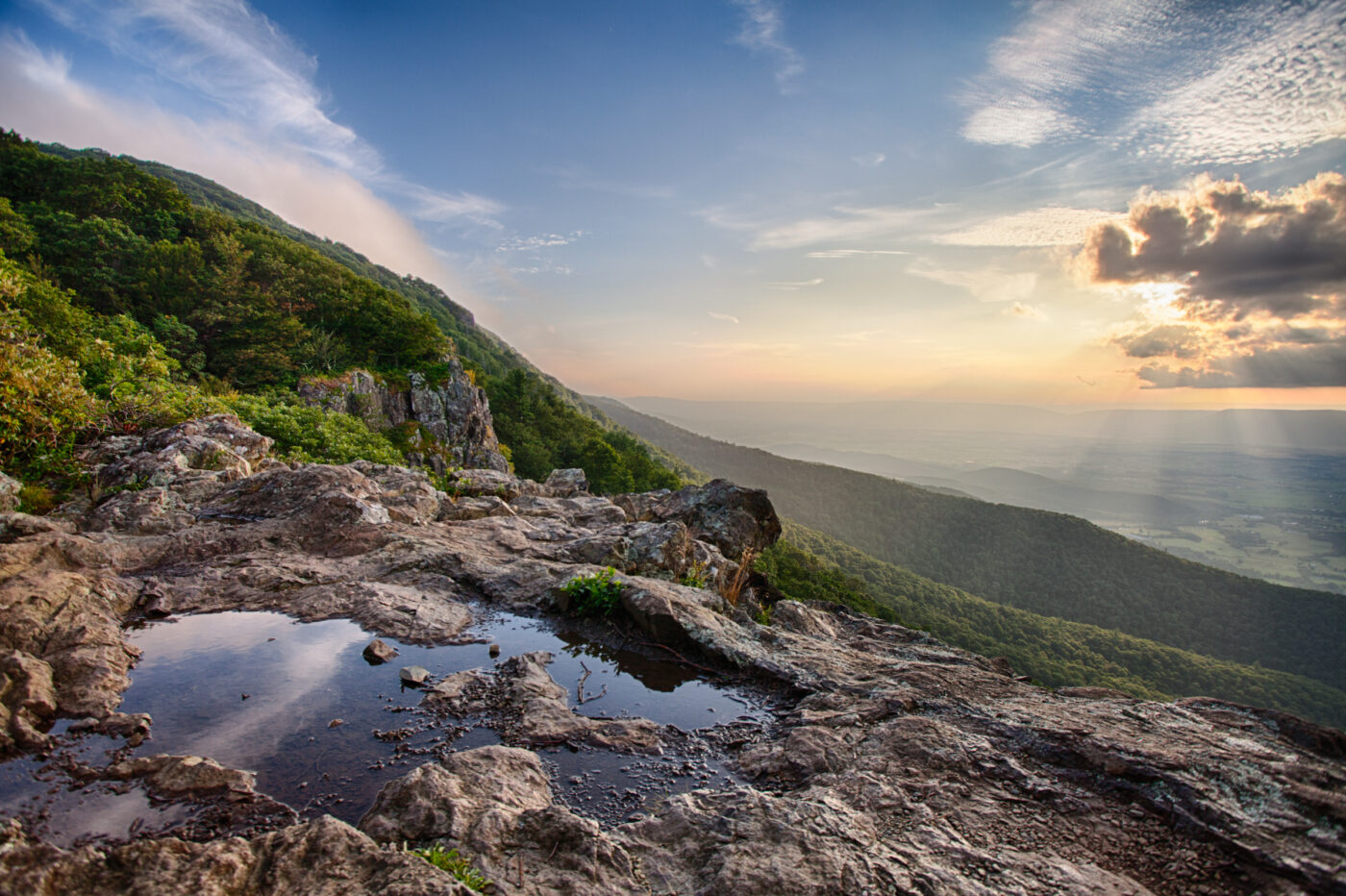
The hike to the summit of Stony Man is one of the most popular in the park.
Central District
The true hub of the park, almost all the most popular attractions are concentrated here. If you’re visiting during peak season, brace yourself for heavy traffic—on the road and on the trail—and crowds at every turn. However, with so much to see and do, you’re sure to have some fun.
Most of the lodging and recreation opportunities in this part of the park are concentrated in the Skyland Lodge and Big Meadows areas. Skyland has a long history as a recreation destination that dates to before the park’s founding. Many of the park’s most popular trails are located just off the lodging complex and you can even grab an ice cream at the lodge after a long day on the trail.
While you’re in the area, AMC trip leader Peter Mason recommends walking Limberlost Trail and taking in the views from the summits of Stony Man and Hawksbill. He also recommends a hike up Old Rag, the most popular peak in the park. Just keep in mind that it’s a “boundary hike” located about an hour’s drive from the core of the central district or a super long hike to get, which is not recommended if you want to hike it in a day.
Limberlost Trail is an ADA-compliant trail that offers a short, easy walk through the forest. Mason’s recommended route to Stony Man is the Passamaquoddy Loop, which passes an overlook near the cliffs of Little Stony Man and follows a stretch of the A.T. before summiting Stony Man and returning to Skyland. If you’re hiking Hawksbill with kids, Mason recommends the easy Upper Hawksbill Trail. It was a favorite when his daughter was little, and they’d spend the hike identifying the mushrooms, flowers, and animals they saw along the way.
The most popular hike in the park is the trek to the summit of Old Rag. The most heavily trafficked route to the top includes a nearly mile-long scramble atop the ridge. It’s stunning terrain but also punishing. You’ll likely need to use your hands to pull yourself up over some large obstacles (it’s no surprise that Old Rag sees its fair share of search and rescues.) This hike is not recommended for inexperienced or poorly prepared hikers.
Beyond the challenge it presents, it’s also almost always crowded. It’s at its worst on weekends, when Adach and Martin caution that you can expect to find “a few thousand of your best friends on the mountain.” Consider saving this hike for a weekday or the off-season for a more pleasant experience, but even then, you may need to wait in line to cross more challenging obstacles.
South of Skyland and Old Rag is Big Meadows, the largest open space in the park. It’s a great place for wildlife spotting, especially in the early morning or late-afternoon. White-tailed deer and even black bears frequent the meadow to snack on berries and other vegetation. You’ll even see bird species found nowhere else in the park. It’s also a prime location for stargazing and rangers lead occasional night-sky watch parties there. Popular hikes in the area include routes to Dark Hollow Falls, Lewis Falls, and Rapidian Camp.
Built in 1929, Rapidian Camp was the presidential retreat for President Herbert Hoover. It now features exhibits on Hoover’s life and presidency, and visitors can get a glimpse inside its historic buildings. Check the ranger program schedule on the park’s website to find out when the buildings are open. Even if the buildings are closed, there are numerous interpretive displays throughout the camp to check out. There’s also a guided hike around the camp on the park’s app and a virtual tour of the camp’s interior on the park’s website. The best way to access the camp is to hike in from Milam Gap.
South District
If you’re coming to Shenandoah for solitude, you’ll have your best chance of finding it here. Like the North District, the South is less crowded than the park’s central zone and it’s even more remote. You’ll find the most visitor services at Loft Mountain, including a campground, camp store, and an amphitheater that hosts ranger-led programming.
Looking for a challenging hike? Riprap-Wildcat Ridge takes hikers to incredible views, past a set of cascades, and even to a small swimming hole. You’ll also find plenty of prime backcountry camping sites. The nearby Turk Mountain Trail is a short, easy hike to peak with awe-inspiring views.
The southern terminus of the park is at Rockfish Gap, which as its name suggests is a gap in the Blue Ridge Mountains between the Shenandoah Valley and eastern Virginia. Trails through the gap that were blazed by Native Americans provided European settlers with the earliest routes through this landscape.
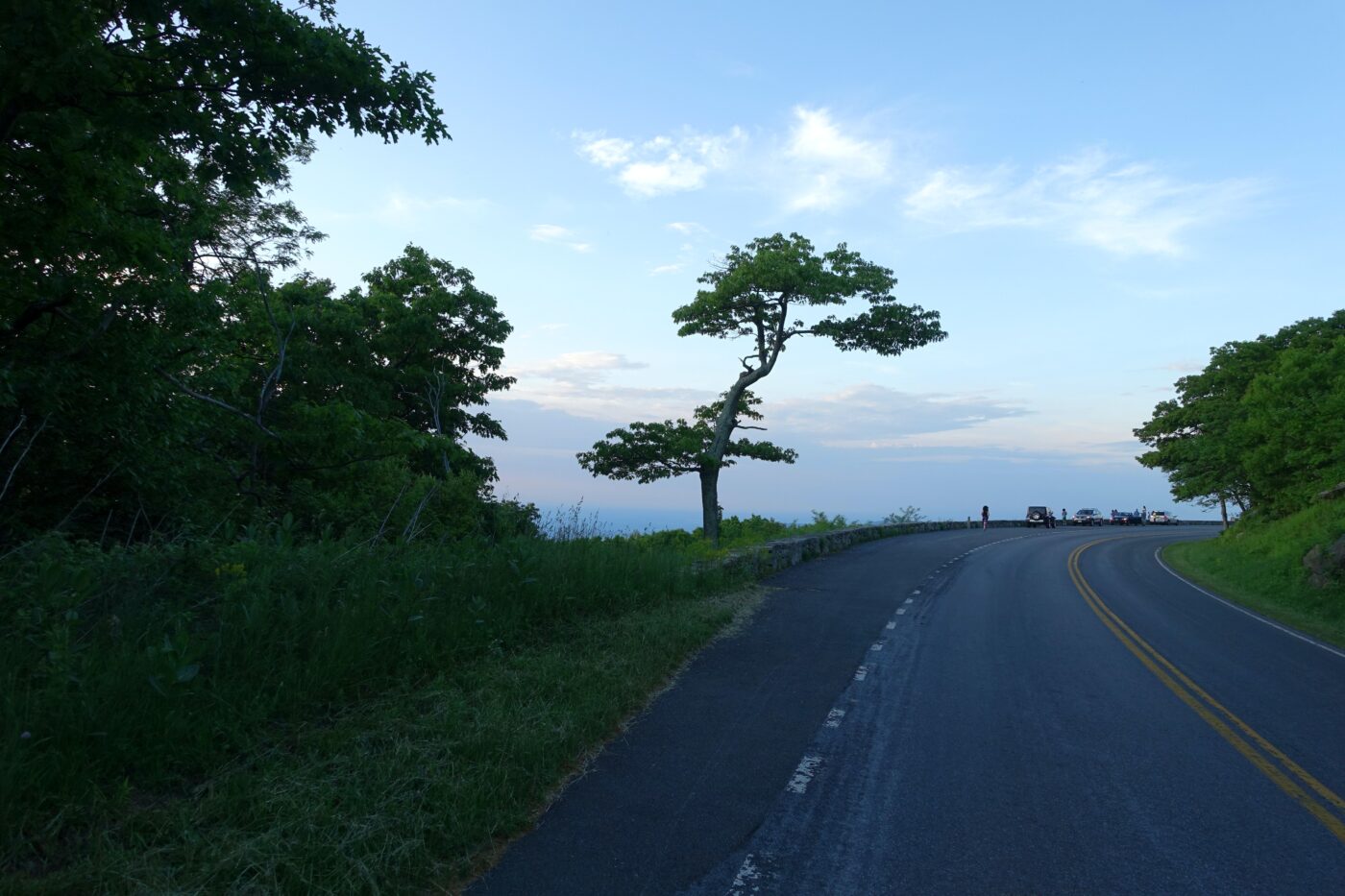
Skyline Drive is a bucket list-worthy ride for experienced cyclists.
Biking: If you’re making a cycling bucket list, Skyline Drive deserves to be on it. Since the road provides easy access to lodging and trailheads, it’s a true choose-your-own-adventure experience. You can also bike the whole road, just make sure you’re prepared for the challenge.
A full traverse of Skyline Drive is best suited for advanced road cyclists. There’s over 15,000 feet of uphill climbing along the route, so every one of the 75 scenic outlooks along the way are hard-earned. The park’s centrally located lodges make it easy to turn this into a two-day trip or you can camp along the way.
Whatever you decide, ride safe. You’ll be sharing the road with cars and hikers, and it can get congested during peak season. Along with steep hills, the road has numerous blind curves and is also prone to heavy fog. For a less challenging ride, several local businesses offer bike tours of the park with seasoned trip leaders and vehicle support.
Other than Skyline Drive, the park’s cycling opportunities are limited. Bikes, including all classification of e-bikes, are allowed on paved areas of the park but there are no designated trails for cycling. The only spot you can bike is a short stretch of Rapidian Fire Road.
Winter Sports: The snowy months offer plenty of opportunities for recreation, including cross-country skiing and snowshoeing. The short, flat Limberlost Trail is an especially great spot for beginner cross-country skiers. Other popular spots to ski include Rapidan Fire Road, which leads to President Herbert Hoover’s fly-fishing retreat, and the Big Meadows area which is the largest open area in the park. Weakley Fire Road is a nice ski through the valley between Old Rag and Robertson Mountain.
If Skyline Drive is closed due to ice and snow you can hike, snowshoe or ski into the park from access points along the park’s boundary.
Rock climbing: The same craggy granite outcrops that draw droves of hikers to Shenandoah also make it an outstanding destination for rock climbing. AMC Member and experienced climber Jason Reed gave us his recommendations for the best places to climb in the park.
Old Rag, the most heavily trafficked hike in the park, also offers some of the best climbs. “[It’s] one of Virginia’s classic climbing destinations,” Reed says. “It offers everything from trailside bouldering to two-pitch trad lines. On the west-facing side of the peak, the Summit Area Crags have a long approach (at least 5 miles, depending on your route), the longest routes, and the most breathtaking views, but the area is also cooler in summer because of the elevation. Ascending the left side of the cliff, Pure Fun is a beautiful, 5.7 single-pitch trad route to the top of the mountain. It follows a crack into a small roof before topping out with summit views.”
He also recommends the Skyline Wall, just east of Old Rag’s summit. He says it has “grippy routes in a variety of ranges with amazing views. You can even find beginner options in the 5.5 range, like Keyhole Left, a 65-foot corner-and-crack combo that’s way more fun than the grade suggests.”
Keep in mind that Old Rag sits within a federally designated wilderness area, meaning it has the highest level of protection available on federal lands. According to park botanist Wendy B. Cass the summit area is home to “globally-rare ecological communities that are sensitive to human impacts.”
Cass says, “It is vitally important for climbers on Old Rag to be aware of how special it is and to show strong respect and care for the plants and animals that live on and around these wonderful climbing areas.” Always practice Leave No Trace principles, especially when going off the beaten path access climbing areas, to help preserve the ecological integrity and wilderness quality of the area.
If you aren’t familiar with the park or you’re relatively new to climbing, Reed recommends taking a guided climbing trip with Shenandoah Mountain Guides. If you’re curious about climbing grades, check out this guide.
For more resources to plan your trip to Shenandoah, explore the park’s website, and consider downloading the official NPS app to view interactive maps, self-guided tours, accessibility information, and much more. The park’s rangers are also a fantastic resource for customized adventure recommendations, so take the time to chat with one while you’re there. See you on the trail!